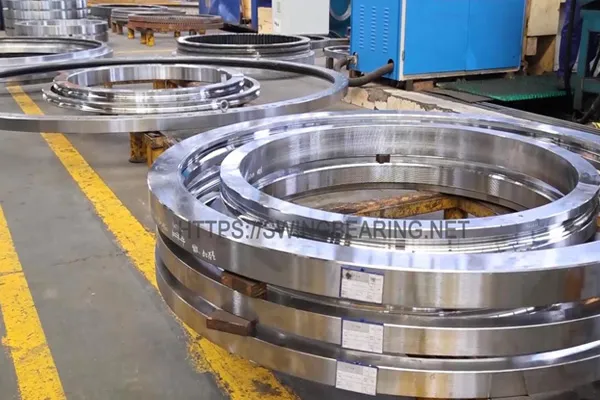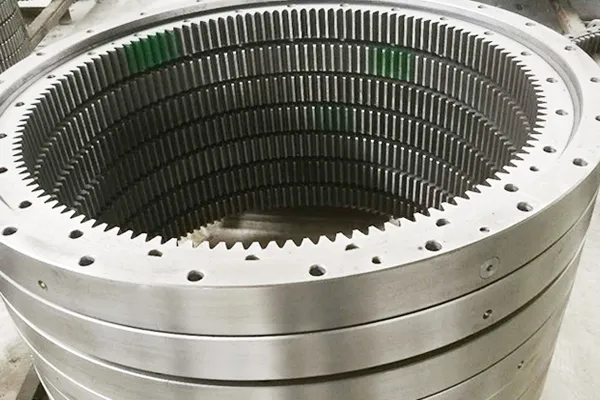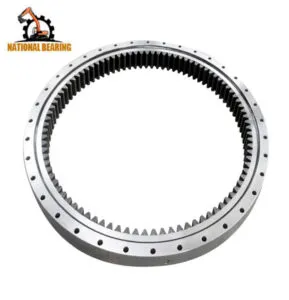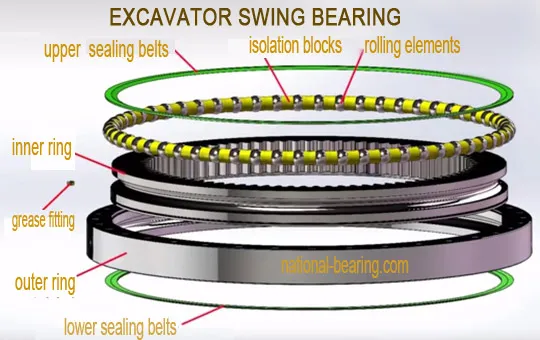
Раскрытие скрытой силы: Поиск опорно-поворотного кольца в экскаваторе
Поворотное кольцо(slew ring), также известное как подшипник поворота, является важнейшим компонентом экскаватора. Он расположен в основании верхней конструкции экскаватора и позволяет верхней конструкции вращаться относительно ходовой части. Поворотный круг отвечает за передачу веса верхней части конструкции и силы копания на ходовую часть. Он также позволяет экскаватору поворачиваться из стороны в сторону.

Поворотный круг экскаватора
Сайт поворотный круг, a crucial component in an excavator, plays a pivotal role in enabling the machine’s upper structure to rotate smoothly upon its lower structure. Understanding its location is essential for maintenance and repair purposes.
Опора поворота обычно располагается в основании верхней части экскаватора, где она сопрягается с нижней частью конструкции. Он состоит из двух концентрических колец, одно из которых крепится к верхней части конструкции, а другое - к нижней. Кольца разделены рядом элементов качения, таких как шарикоподшипники или ролики, которые облегчают вращение.
Чтобы найти подшипник поворота, начните с определения верхней и нижней частей экскаватора. Верхняя конструкция - это часть, на которой расположены кабина, стрела и рукоять, а нижняя конструкция включает в себя гусеницы или колеса и ходовую часть.
Определив верхнюю и нижнюю структуры, найдите точку их соединения. Как правило, это круглое или шестиугольное отверстие в центре верхней конструкции. В этом отверстии расположено поворотное кольцо.
В некоторых экскаваторах поворотный подшипник может быть частично или полностью закрыт защитным кожухом. Этот корпус служит для поддержания опорно-поворотного кольца в чистоте и смазке, что продлевает срок его службы. Чтобы получить доступ к опорно-поворотному кругу, может потребоваться снять корпус.
Расположение поворотного кольца может несколько отличаться в зависимости от конкретной модели экскаватора и производителя. Однако, как правило, оно находится в основании верхней части конструкции, где обеспечивает стабильное и надежное соединение между верхней и нижней частями конструкции.
Понимание расположения опорно-поворотного устройства имеет решающее значение для технического обслуживания и ремонта. Регулярный осмотр и смазка опорно-поворотного устройства необходимы для обеспечения его надлежащего функционирования и предотвращения преждевременного износа или выхода из строя. Зная, где находится опорно-поворотное кольцо, технический персонал может эффективно выполнять эти задачи, максимально увеличивая производительность и долговечность экскаватора.
Подшипник поворота, важнейший компонент экскаватора, расположен в основании верхней части конструкции, где он соединяется с нижней. Такое стратегическое расположение позволяет верхней конструкции вращаться плавно и эффективно, позволяя экскаватору выполнять широкий спектр задач.
Поворотный круг состоит из двух основных компонентов: внутренней и внешней шестерни. Внутренняя шестерня крепится к верхней конструкции, а внешняя - к нижней. Когда оператор экскаватора включает двигатель поворота, внутренняя шестерня вращается, приводя в движение внешнюю шестерню и заставляя верхнюю конструкцию поворачиваться.
The slew ring plays a vital role in the excavator’s functionality. It provides a stable and reliable connection between the upper and lower structures, ensuring smooth and precise rotation. Without a properly functioning опорно-поворотный круг, the excavator would be unable to perform its intended tasks effectively.
Расположение поворотного круга в основании верхней части конструкции не только практично, но и выгодно. Такое расположение обеспечивает легкий доступ при техническом обслуживании и ремонте, сводя к минимуму время простоя и обеспечивая непрерывную работу экскаватора.
Помимо своей основной функции, поворотный круг также способствует общей устойчивости экскаватора. Обеспечивая прочное соединение между верхней и нижней частями конструкции, он помогает равномерно распределить вес экскаватора, предотвращая его опрокидывание во время работы.
Кроме того, расположение опорно-поворотного устройства у основания верхней части конструкции позволяет устанавливать дополнительные компоненты, такие как гидравлические линии и электропроводка. Эти компоненты, необходимые для работы экскаватора, удобно прокладываются через опорно-поворотное кольцо, обеспечивая их защиту и функциональность.
В заключение следует отметить, что опорно-поворотный круг - это важнейший компонент экскаватора, расположенный в основании верхней части конструкции. Его стратегическое расположение обеспечивает плавное вращение, устойчивость и облегчает установку основных компонентов. Понимание функций и важности опорно-поворотного устройства имеет решающее значение для обеспечения эффективной и надежной работы экскаватора.
The slewing ring is a vital component in an excavator, playing a pivotal role in enabling the upper structure to rotate smoothly upon the undercarriage. Understanding its location, structure, and function is essential for troubleshooting common issues related to this critical part. This detailed guide will help you identify, diagnose, and resolve problems associated with the slewing ring, ensuring your excavator operates efficiently.
The slewing ring is typically situated at the base of the excavator’s upper structure, where it interfaces with the lower frame. It comprises two concentric rings: one fixed to the upper structure and the other to the lower frame. Between these rings are rolling elements, such as ball bearings or rollers, that facilitate the rotation of the upper structure.
To access the slewing ring, it is necessary to remove the upper structure from the undercarriage. This involves several steps:
Once the upper structure is detached, the slewing ring becomes visible as a large, circular component located at the base of the upper frame.
The primary function of the slewing ring is to facilitate the rotation of the excavator’s upper structure relative to its undercarriage. This allows the operator to maneuver the boom, arm, and bucket with precision, enhancing the excavator’s versatility and efficiency. The slewing ring must withstand significant loads and stresses during operation, making its proper maintenance and functioning critical.
One of the most common issues with the slewing ring is excessive wear. This can result from various factors, including heavy usage, inadequate lubrication, and contamination. Symptoms of excessive wear include:
To diagnose excessive wear, perform the following checks:
If excessive wear is confirmed, take the following steps:
Proper lubrication is crucial for the smooth operation and longevity of the slewing ring. Inadequate or incorrect lubrication can lead to increased friction, overheating, and premature failure.
Signs of lubrication problems include:
To resolve lubrication issues:

Подшипник скольжения экскаватора
Bearing failure in the slewing ring can have severe consequences, including total operational shutdown. This issue can be caused by various factors, including overloading, poor maintenance, and manufacturing defects.
Symptoms of bearing failure include:
If bearing failure is suspected:
Regular monitoring and maintenance are crucial for preventing issues with the slewing ring and ensuring its optimal performance.
Perform scheduled inspections to identify potential issues before they become severe:
Ensure that operators and maintenance personnel are adequately trained:
The slewing ring is a critical component of an excavator, enabling the upper structure to rotate smoothly upon the undercarriage. Understanding its location, structure, and function is essential for troubleshooting common issues and ensuring optimal performance. By regularly inspecting, maintaining, and addressing issues such as excessive wear, lubrication problems, and bearing failure, you can prolong the life of the slewing ring and enhance the overall efficiency and reliability of your excavator.
By following these detailed maintenance practices, you can ensure that your excavator’s hydraulic system remains in top condition, providing reliable performance and longevity. Regular monitoring, proper lubrication, and timely replacement of worn components are key to preventing common issues and maintaining the efficiency of the slewing ring.

Конструкция поворотного круга
1. Где расположен поворотный круг в экскаваторе?
- Поворотное кольцо расположено между верхней и нижней конструкциями экскаватора.
2. Какова функция поворотного круга в экскаваторе?
- Поворотный круг позволяет верхней части экскаватора вращаться относительно нижней.
3. Какие различные типы опорно-поворотных устройств используются в экскаваторах?
- Существует два основных типа опорно-поворотных кругов, используемых в экскаваторах: опорно-поворотные круги на шарикоподшипниках и опорно-поворотные круги на роликовых подшипниках.
Опорно-поворотный круг, также известный как подшипник поворота, - это важный компонент, расположенный в основании верхней части экскаватора. Он обеспечивает поддержку и позволяет верхней конструкции плавно вращаться на нижней, что позволяет экскаватору выполнять операции по рытью и выемке грунта с точностью и эффективностью.